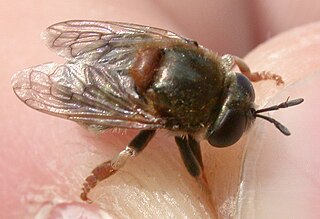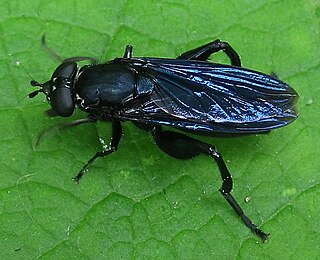
Hover flies of the genus Microdon are unusual among the Diptera. Like other members of the subfamily, they are myrmecophiles, meaning they inhabit the nests of ants.

Xylota is a Holarctic genus of hoverflies similar in structure to the related genera Chalcosyrphus and Brachypalpoides. As the larvae are saprophytic they're usually found in rotting wood. The adult flies are generally associated with woodland and woodland edges and can often be seen running over the upper sides of leaves. Unlike other syrphids the adults of many species rarely visit flowers preferring instead to gather pollen from leaf surfaces. There are over 100 described species of which 12 can be found in Europe. Seven species have been recorded in Britain. Identification of species has been difficult and identifiction by photographs is risky.

Ceriana is a genus of hoverfly. All species are wasp mimics.

Chalcosyrphus is a genus of hoverflies in the subfamily Eristalinae. Many species exhibit some degree of mimicry of various sawflies and other hymenopterans and are often brightly coloured or metallic in hue. The adults are similar in structure and behavior to the related genus Xylota but differ in larval morphology. They can be found throughout Europe, Asia, and North America and seem to prefer damper, boggy habitats. The larvae are saproxylic feeders in rotten wood in these habitats.

Monoceromyia is a genus of hoverfly. Species in the genus are found in the Afrotropical, Australasian, Neotropical and Oriental regions. They are mimics of wasps and the genus is distinguished by the metapleura being widely separate behind the hind coxae. The elongated frontal base of the antenna is at least as long as the basal segment of the antenna and the second abdominal tergum is longer than wide and constricted.

The Milesiini is a large and diverse tribe of hoverflies. They mimic wasps or hornets.
Paratropidia is a subgenus of hoverflies from the family Syrphidae, in the order Diptera.
Chalcosyrphus ventralis is a species of hoverfly in the family Syrphidae.
Chalcosyrphus victoriensis is a species of hoverfly in the family Syrphidae.
Deineches is a genus of hoverflies from the family Syrphidae, in the order Diptera.
Deineches fulva is a species of hoverfly in the family Syrphidae.
Deineches hackeri is a species of hoverfly in the family Syrphidae. It is endemic to Australia.
Malometasternum rufocaudata is a species of hoverfly in the family Syrphidae.
Odyneromyia is a genus of hoverflies in the family Syrphidae.
Odyneromyia illucens is a species of hoverfly in the family Syrphidae.
Odyneromyia iridescens is a species of hoverfly in the family Syrphidae.
Orthoprosopa is a genus of hoverflies from the family Syrphidae, in the order Diptera.
Orthoprosopa multicolor is a species of hoverfly in the family Syrphidae.
Sterphus is a genus of hoverflies.
Cydistomyia is a genus of horse flies in the family Tabanidae.





